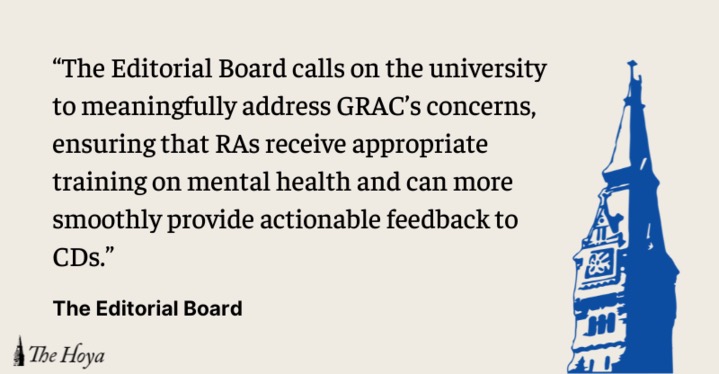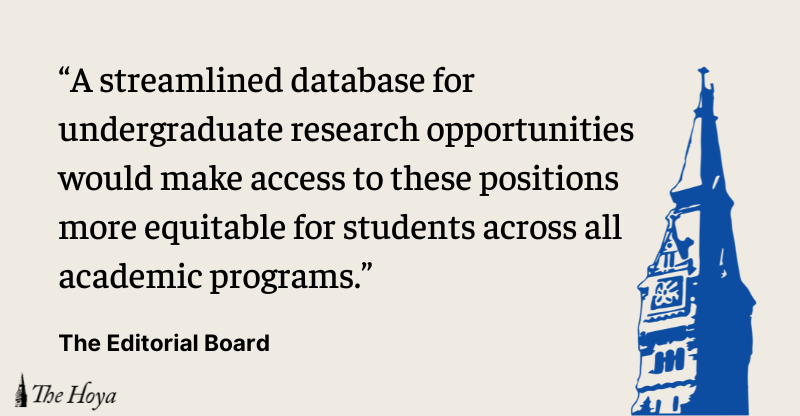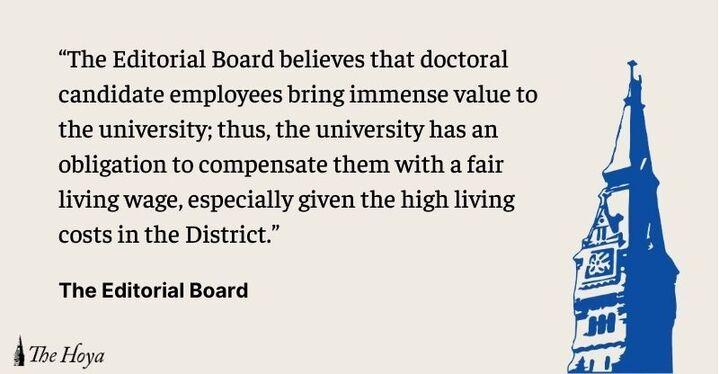The recent swearing-in of Georgetown University Student Association President Sahil Nair (SFS ’19) and Vice President Naba Rahman (SFS ’19) brings to mind their campaign promises of an inclusive and opportunity-driven approach to GUSA. However, the pair must overcome significant shortcomings in its institutional knowledge to enact clear policy priorities.
As this editorial board warned in its Feb. 16 endorsement of former GUSA executive candidates Josh Sirois (SFS ’20) and Casey Doherty (COL ’20), Nair and Rahman lack the institutional knowledge of GUSA necessary to implement the inclusive policies they seek.
Former GUSA President Kamar Mack (COL ’19) and Vice President Jessica Andino (COL ’18) faced a similar barrier upon their inauguration and were plagued by a lack of cohesive vision and an inability to execute or monitor projects throughout their term. Mack and Andino, like Nair and Rahman, had no prior experience in the GUSA senate or executive. Their misunderstanding of policy-making processes showed in their governance — policies were mismanaged and students were underserved.
To remedy this concern, Nair and Rahman should draw on the experience of those with GUSA experience by positioning them in leadership roles. The inclusion of Aaron Bennett (COL ’19) —previously Mack and Andino’s press secretary — as campaign manager is a positive step, but Nair and Rahman should integrate GUSA insiders into policy roles and consult insiders throughout the semester.
Nair and Rahman must also clearly determine and state their priorities to avoid a wide-reaching but ultimately ineffective term. Their platform, which included 30 policy areas, too often centered on vague aspirations and buzzwords like “creating options,” “grow transparency” and “elevate voices.” The pair should clarify concrete, actionable priorities under its three existing platform pillars: inclusivity, accountability and opportunity.
The executives’ inclusivity focus is best served by pursuing the concrete, achievable projects discussed in other candidates’ platforms. For example, Sirois and Doherty’s plan to add a wheelchair accessible entrance to the first floor of Lauinger Library is a meaningful step toward a campus that better serves all of its students; Nair and Rahman should incorporate this proposal into their inclusivity priorities.
Moreover, this GUSA executive can promote accountability by addressing the affordability problems that plague many Georgetown students. Nair and Rahman should consider policies like those proposed by former GUSA executive candidates Hunter Estes (SFS ’19) and Richard Howell (SFS ’19), who called for professors to reduce textbook expenses by posting relevant excerpts of textbooks and other readings online.
Nair and Rahman should also prioritize university transparency on the use of students’ tuition dollars. Right now, data about how Georgetown spends tuition money is available only through an appointment with the Provost; this data should be freely available to all students through MyAccess or a similarly convenient forum.
To foster opportunity for students, Nair and Rahman have stated a desire to meet with every student group as a key component of their “Because Every Voice Matters” campaign. The sheer multitude of clubs makes this goal wholly unrealistic. However, their community advisory groups, which they describe as “collections of student clubs and groups organized by issue area of interest,” could serve as effective means to integrate new voices and perspectives into student government. Targeted focus groups with specific themes or purposes like social advocacy groups or cultural organizations could efficiently incorporate the voices of Georgetown students to yield necessary social change.
This editorial board believes Nair and Rahman are certainly capable of a productive year as GUSA executives. The first step on this path, however, is the prioritization of clear policy goals and the incorporation of those with GUSA experience.
The Hoya’s editorial board is composed of six students and is chaired by the Opinion Editor. Editorials reflect only the beliefs of a majority of the board and are not representative of The Hoya or any individual member of the board.








Jack the Bullfrog • Apr 6, 2018 at 10:05 am
I have seen many bad takes from the Editorial Board. This one may be the worst. No organization has more singularly perpetuated the myth of GUSA incompetence than the Editorial Board. At some point, these screeds against “outside” administrations have to be taken, not as ignorance, but as bad faith.
For example:
Both Mack and Andino worked in GUSA before their election. Mack was on the Federal Relations team, and Andino worked in free speech.
This article operates on the presupposition that candidates should produce intricate platforms. Not only does this idea unfairly prejudice against non-institution candidates; it does not make sense. Sirois and Doherty, despite their touted GUSA knowledge, just presented their awareness of the issues. Neither of them, despite their strong advocacy positions, had introduced solutions. Sirois and Doherty already worked in accessibility-related fields. It was within their power to advocate for the wheelchair ramp, but they did not produce evidence indicating that they had.
Similarly, Estes and Howell wanted professors to scan textbooks? Ignoring the fact that is already a widespread practice and is of dubious legality, it is outside of GUSA’s purview. GUSA is housed under student affairs, while textbook use is an academic affairs decision (such a proposal would more appropriately connect with the academic councils than the student association).